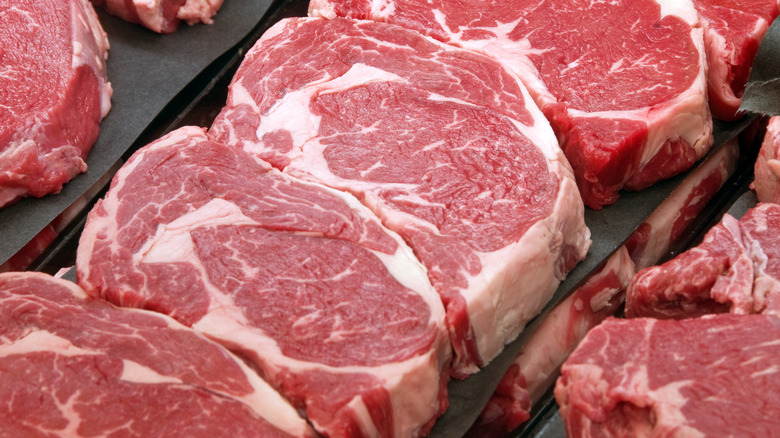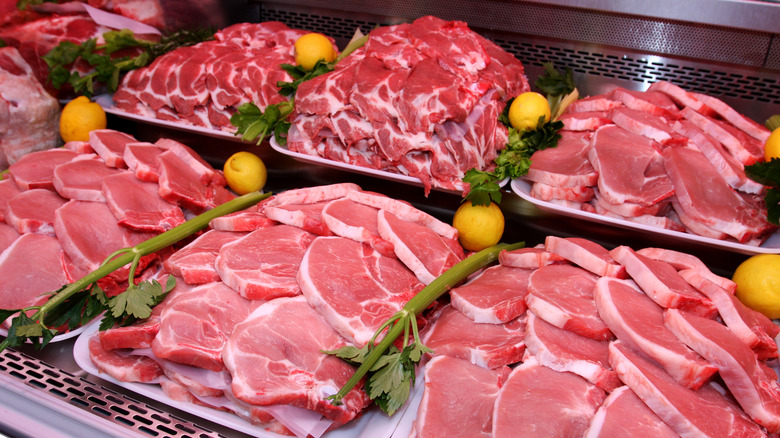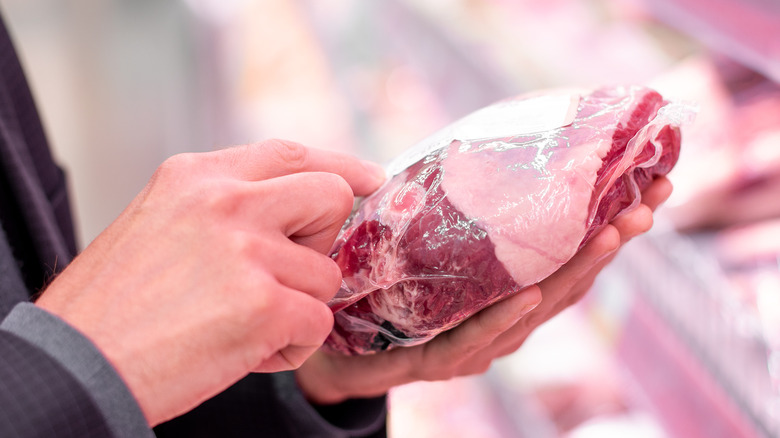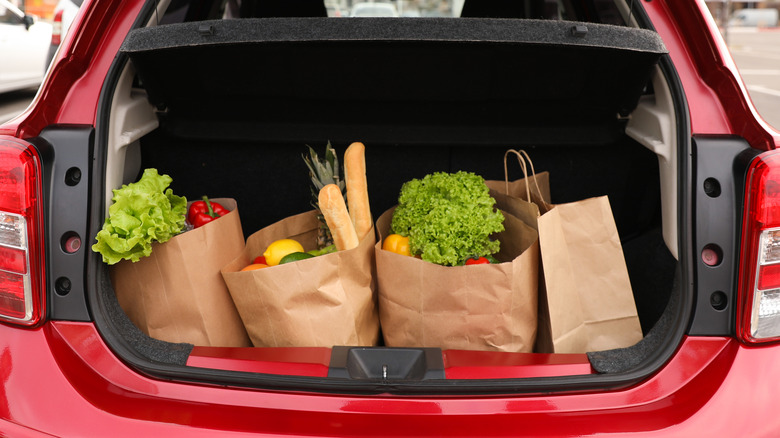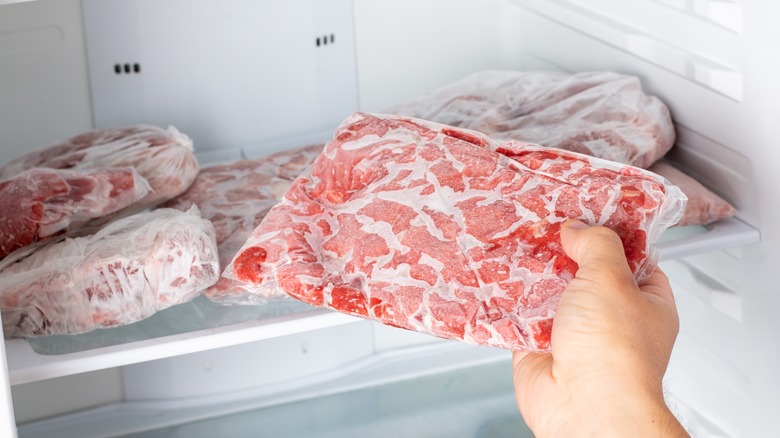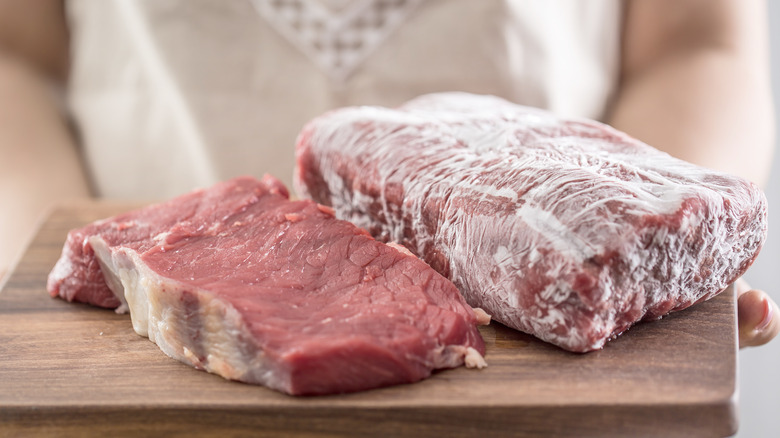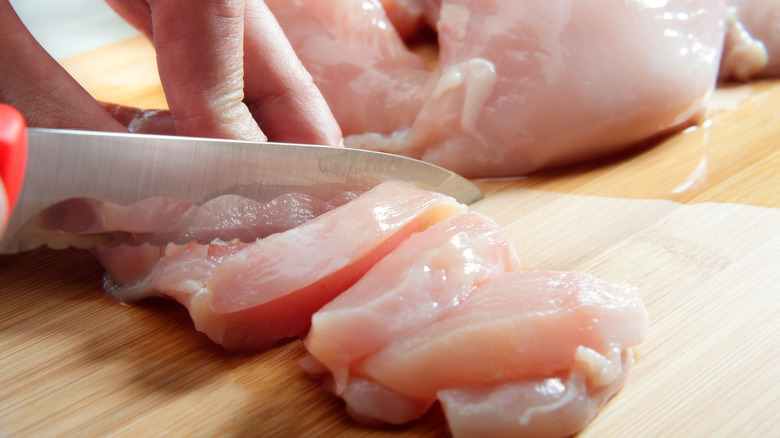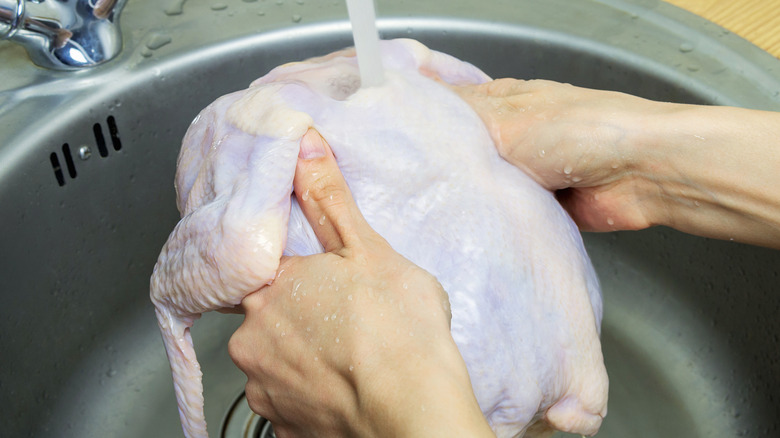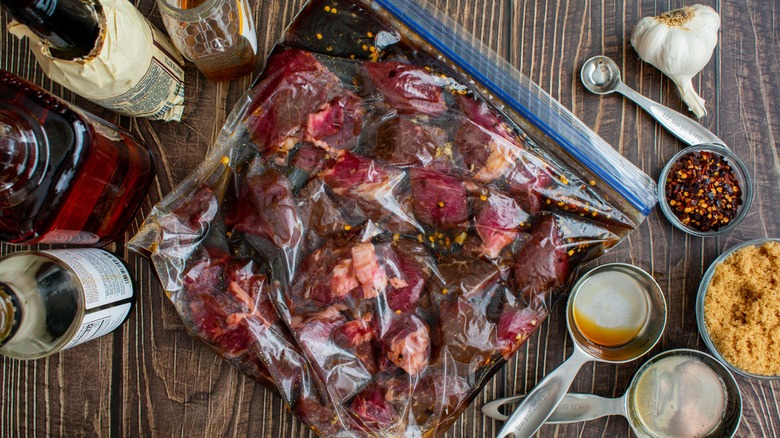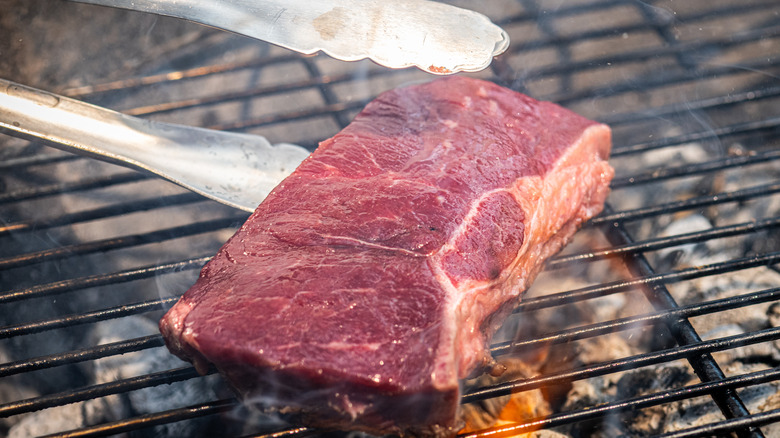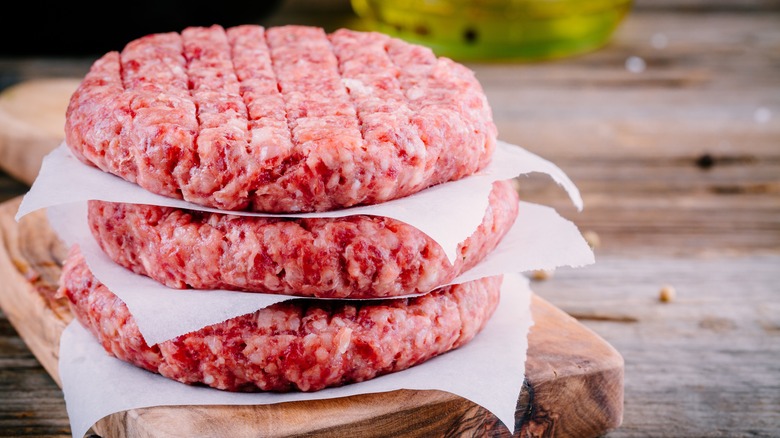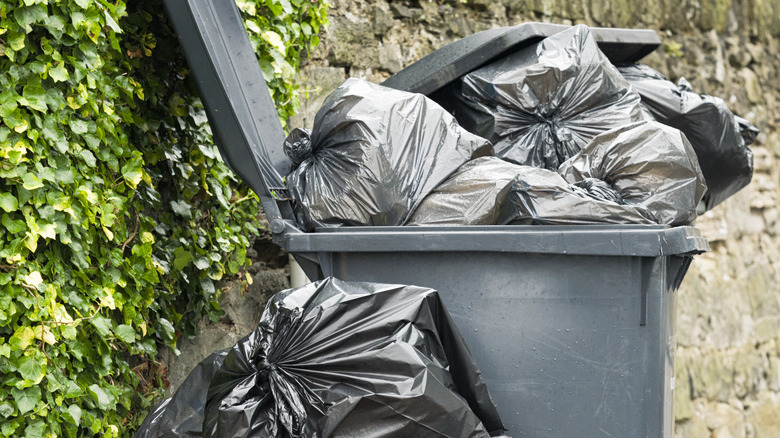Mistakes Everyone Makes With Raw Meat
Savory steaks. Lush burgers. Succulent chicken. Tender flaked fish. Few things are more indulgent or delicious than a perfectly cooked piece of meat. Over the years, we've all heard a lot about the essential rules and practices for grilling, roasting, or pan-searing various cuts of meat to perfection. Season generously with plenty of salt, pepper, and spices. Always preheat your oven or grill. Test frequently to measure doneness. Let your cooked meat rest for optimal juiciness.
As important as all these rules are, consider this: many of the problems that can plague a meat-based entree or potentially even make you sick actually occur well before you ever put your beef, poultry, pork, or seafood on to cook! That's right. There are mistakes everyone makes with raw meat that ruin dishes, increase the risk of food safety issues, and just leave dishes less spectacular than they might otherwise be.
But while these mistakes do happen to so many of us, they're also easy to fix or prevent with a bit of preparation, foresight, and planning. Here's what you need to know to avoid these common raw meat errors, and make the most incredible protein-packed meals possible!
Buying poor quality meat to start with
Whether you're making a classic old-school meatloaf just like mom used to make, batch-cooking chicken to get you through the upcoming work week, or prepping a feast that's sure to impress (like Ina Garten's beloved red wine-braised short ribs), every good meat-based dish starts with quality ingredients. You need to buy the best raw meat possible!
When you're shopping in the meat aisle at your favorite market, always look for beef or pork that has a fresh, vibrant color and is free from any noticeable damage or any weird green, gray, or blueish tints. Opt for cuts with even, visible marbling (or streaks of fat) throughout, as this indicates a higher-quality cut. Fish, too, should have bright, rich colors and should feel firm and resilient to the touch. Poultry should have a pinkish hue, with skin that is pale and slightly translucent. Steer clear of anything that appears grayish, or that has dark spots.
Regardless of the type of meat, it should smell clean and perhaps slightly sweet or briny. Avoid raw meat with any sort of intense, pungent, or ammonia-like aroma. The packaging for high-quality meat should be completely free from tears, punctures, or leaks. If you see excess liquid surrounding your raw meat, don't buy it! Any sort of built-up blood or juice can indicate that the meat has been sitting for a while or has not been properly stored. Buying it is a definite mistake — you can do better.
Ignoring expiration dates
Once you've landed on a package of raw meat that passes the "look, touch, and smell" test, take an extra second to check its label as well. Many of us look at the expiration date religiously when buying milk, but we don't put the same care and caution into our meat, assuming that if it looks OK, it must be OK. This is one bad habit it pays to break.
When you first look at the label on your raw meat, check for anything noting a possible previous inspection, like a stamp from the USDA. This signifies that the meat had passed a federal safety and quality check. Lower-grade raw meats might not undergo such an inspection. After that, check the label for terms like "sell by," "use by," and "best by." "Sell by" dates are for retailers — they tell the grocery store when the meat needs to be off its refrigerated shelves. But, as a consumer, they will also clue you into the age of the meat. The closer it is to the "sell by" date, the older the raw meat is. You can still buy it if the date is close, but you may want something fresher with a further off date.
"Use by" and "best by" are notifications explicitly geared toward consumers. They let you know how long you have to use the meat for optimal quality. If that date is close, you might want to pick a different package to ensure maximum freshness.
Putting raw meat in the wrong bag
The raw meat mistakes don't end once we get past the register — they just grow exponentially. We get it — we're all in a hurry, so shoving a pack of scallops or cartons of chicken legs in your bag and piling a couple of pre-made salads or a bag of chips on top may not seem like a big deal. But what happens then, on the way home, if your meat leaks or the package tears slightly and juice streams down across all your other groceries? You may not even know it happened until a week later when you're snacking from that same bag of chips on the couch and end up getting sick for seemingly "no reason."
The take-home advice: always put your raw meat in its own bag, even if it seems like a bother. And if you use reusable grocery bags, make sure to clean them regularly to prevent cross-contamination and the potential buildup of bacteria from raw meat juices.
Beyond bagging, try to avoid putting raw meat in the trunk of your car, especially if it's hot out. Instead, keep it inside the car with you where the temperature is better controlled. Never leave your meat sitting out in the car and exposed to direct sunlight — it's a surefire way to promote bacterial growth. And, if it will take a while to get home, pack a cooler, ice packs, or frozen gel packs in your car to help keep your meat as cold as possible.
Not storing your raw meat properly
Even when raw meat makes it home safe and sound — free from the risk of cross-contamination or untold minutes spent spoiling in an overly hot trunk — you're not out of the woods. There are still plenty of potential mistakes that can be made — many right within your fridge
Storage problems with raw meat can begin with something as simple as the temperature you have your fridge set to. Even a well-functioning refrigerator that's set at too warm a temp can allow bacteria to grow rapidly on raw fish, meat, and seafood. The ideal fridge temp for storing perishable foods, including raw meat, is 40 F. If you're in doubt over just how accurate the temperature settings on your fridge are, you can pick up a professional-grade thermometer made especially for fridges for just a few bucks.
Assuming your fridge is nice and cool, storage mistakes are still fairly common. For starters, don't transfer your raw meat to another container unless you are about to use it. The tightly sealed packaging that raw meat is sold in is also ideal for home storage unless that packaging has been damaged in some way. If that has happened, store your meat covered in plastic wrap in an airtight container. You should also avoid storing different raw meats together or with other foods — either cooked or raw. And perhaps most importantly, try to keep all raw meat on the bottom shelf of your fridge; this prevents potential drips onto other food.
Not freezing your meat properly
If you don't plan on using fresh meat within a few days of purchase, don't leave it sitting in your fridge. Its quality can quickly deteriorate. Instead, meat that requires extended storage should always go straight into the freezer.
While it's never a good idea to move raw meat into a new container just to store it in your fridge, this is not true when it comes to freezing! The plastic wrap on raw meat is often too fragile. It can tear easily or may allow moisture to escape, triggering what we commonly call "freezer burn." To safely freeze raw meat, you should instead always wrap that raw meat tightly in freezer-grade plastic wrap or aluminum foil. Or, simply pack it into a large freezer bag. Before plopping your meat into the freezer, also take an extra second to squeeze out as much air as possible from the packaging. This is another key step in protecting your meat's quality and ensuring it tastes just as good coming out of the freezer as it did going in.
Large portions of meat should be divided into smaller servings before you put any meat in to freeze. Also, label the packaging with the type of meat and the date of freezing. This will allow you to keep track of how long it has been stored. Finally, place the wrapped meat in the coldest part of the freezer. This helps it to freeze quickly — another essential step for maintaining quality.
Thawing meat the wrong way
Freezing steaks, chicken, or pork to use later is a great way to avoid mistakes that happen with refrigeration. But it does set up the potential for a whole different set of issues, this time centered around thawing. While it might seem simple, there's a right and wrong way to let your meat thaw!
Many of us will pull a package of frozen meat out from the icebox, set it on the counter or in the sink, and let it gradually come to room temperature over the next hour or two. But that's a huge mistake. The meat's exterior will warm before the interior, and its surface can become a breeding ground for bacteria. The same thing can happen if you soak the frozen meat in hot water. The exterior of the meat warms, and bacteria can begin to form before the interior of the meat ever has a chance to thaw.
Instead of thawing meat at room temperature, always let it thaw in your fridge. It may take a bit longer, but the exterior of the meat never becomes warm enough for bacteria to form. Similarly, if you want to use water for thawing, make your water cold — not hot — and replace it every 30 minutes until the meat is fully thawed. And if you thaw your meat in the microwave, always use the defrost setting. This will prevent the exterior of your meat from starting to cook while the inside is still raw.
Not carefully preparing your meat
Even though we've all heard so much about the safe handling of raw meat over the years, countless mistakes can still be made when it comes to cutting and preparing our favorite proteins. Many of those mistakes are centered around the surfaces we cut and prep our raw meat on. For instance, while wooden cutting boards are fantastic for all sorts of food cutting and trimming, you should never use wooden boards with raw meat. Bacteria and juices from the meat can penetrate those porous wooden surfaces, making the boards nearly impossible to clean well. So save your giant butcher block — despite the name — and use a plastic, glass, or acrylic board instead when dealing with raw meat.
As you're cooking and prepping your meal, also be sure to keep all your ready-to-eat foods away from that meat board — salad and raw chicken don't mix! The knives, tongs, and other utensils you use with your raw meat should also be kept away from all other foods to avoid possible cross-contamination. And while it may seem like an obvious warning, it bears repeating: Always wash your hands well with soap and water after handling raw meat. Use warm water, not cold, and wash for at least 20 seconds in order to reduce your risk of spreading potentially harmful bacteria to other foods you might be cooking or handling.
Washing raw meat before cooking it
Maybe your co-worker swears by washing her chicken before she puts it in the oven to bake. Perhaps your spouse is a clean freak and insists steaks should be washed before you ever bring them near a skillet. Whatever the case, the only thing these folks and thousands of others who also wash their raw meat before preparing it are actually doing is spreading potential germs all around their kitchen. It's another common mistake many of us make with raw meat, and one that even the USDA advises against.
When you wash raw meat, no matter how careful you are, tiny droplets splatter all over your sink and everything surrounding it — your dish soap, your sponge and sponge holder, maybe an air fryer, or coffee maker, or the bowl you keep your dog's treats in. Of course, you can go back later and try to clean up all these splatters, but there's always the risk you'll miss a spot. It's a food-borne illness just waiting to happen.
So what's the alternative if your steak or chicken looks a little damp and you want to do something to it before you cook it? Instead of washing, consider drying the meat instead. Grab some paper towels and dry that meat as best you can. Dab all over and remove any excess liquid from your meat that may have accumulated in the package. Then, throw those paper towels away and continue on with your raw meat prep.
Marinating meat unsafely
Marinades are a godsend when adding flavor to raw meat or making tougher cuts nice and tender. But they can also be the source of a number of raw meat mistakes that many of us make from time to time.
To marinate your meat as safely as possible, don't leave your raw meat and marinade sitting out at room temperature. Keep them in the fridge where bacteria is less likely to form. Don't marinate too long — there is too much of a good thing. Over-marinating can make the meat mushy or leave it packed with too much flavor and spice. In most cases, 30 minutes to 2 hours is plenty. For especially tough cuts like flank steak, skirt steak, chuck roast, pork shoulder, or pork ribs, you can go as long as overnight.
Finally, no matter how tempting or tasty that leftover marinade looks after you remove raw meat, don't reuse it. Either reserve a small amount to use later before you add the meat to it. Or, if you insist on using it, boil it for several minutes and turn it into a sauce.
Not paying attention to cooking temperatures
Unless you're making steak tartare or seafood ceviche, all raw meat gets cooked eventually. In order to make sure your grilled turkey legs or juicy pork sausages turn out as tasty as possible, there are a few rules to cooking raw meat that are always worth remembering. First, whether using a stove, oven, grill, or air-fryer, take a few extra minutes to allow things to pre-heat. This enables cooking surfaces to reach their desired temp before they ever come into contact with your meat — and that's key to ensuring proteins cook evenly and sear and caramelize in just the ways you're hoping they will. Raw meat cooked in an oven or on a grill that hasn't been allowed to preheat is much more likely to be tough or chewy, or still raw in the center when the outside is cooked well.
Beyond pre-heating, don't frequently open grills or ovens while cooking raw meat. This can cause temperature fluctuations and will result in uneven cooking. And most importantly, buy a meat thermometer and use it — it's a mistake not to, no matter how confident you feel in your cooking skills. Beef, lamb, pork, and seafood should be cooked to an internal temperature of at least 145 F before being served. Chicken needs to go a bit warmer, to a nice and toasty 165 F.
Mishandling leftover meat
Maybe you were planning a backyard blowout for all the neighbors and prepped way more classic cheeseburgers than you needed. Maybe you marinated a couple of dozen wings to watch the big game, and then plans changed. Whatever the case, now you have a bunch of leftover raw meat to store.
Step number one in avoiding any potential mistakes here is to make sure that raw meat goes back into the fridge as soon as possible. The longer you leave meat out at room temperature, the greater your risk for potential illness. When you have leftover raw meat, always store it in air-tight packaging — not the wrapper it originally came in — and refrigerate it as soon as possible. If the meat has never been frozen, feel free to wrap it and put it in the freezer. However, if it has already been frozen and thawed once, you shouldn't freeze it again. Instead, plan on cooking those leftovers within a couple of days in order to preserve their quality and reduce the risk of illness.
Even better, instead of trying to store that leftover raw meat and use it later, cook it now. Grill those extra burgers or fry up your surplus wings. Then, store your cooked meat instead. Cooked meat will keep longer and is much less likely to pose a health safety risk. And, your cooked meat can safely be frozen and thawed again later when you're ready to eat it — it's a win-win for everyone.
Sending rotting meat straight to the trash
Even when we follow all the rules, meat can still end up going bad from time to time. When this happens, one last final and super important mistake to avoid is simply tossing that raw meat straight into the trash. Disposing of raw meat like this is problematic for a number of reasons. First off, it stinks. Raw meat can create a terrible odor as it breaks down. It's unpleasant for you and your neighbors, and it draws all sorts of pests, from flies and rodents to raccoons and other wild animals. Rotting raw meat is also a breeding ground for all kinds of bacteria and can turn your garbage can into a major source of contamination.
Instead of throwing raw meat directly into the trash, you have a few different options. If you compost or live near a composting facility, you may be able to dispose of the meat as you would other organic waste. Just know that not all composting systems can handle meat — but if yours can, it's a worthwhile option.
If composting isn't viable, at least try to wrap the raw meat securely in multiple plastic bags. Or, place it in a leak-proof container before disposing of it to help contain odors and prevent leakage. If you have a lot of meat that has spoiled, like after a power outage or appliance failure, call your local waste management authority. Some areas also offer special disposal services for large amounts of food waste.

